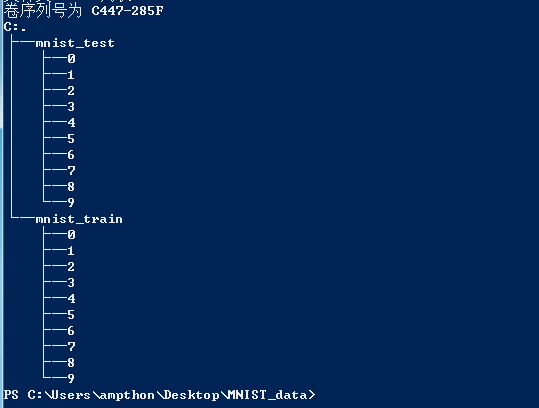第一种方法:
Keras官方给的图片去噪示例要自动下载mnist数据集并处理,不能修改和加入自己的数据集。
from keras.datasets import mnist (x_train, _), (x_test, _) = mnist.load_data() x_train = x_train.astype('float32') / 255. x_test = x_test.astype('float32') / 255.
以上代码实现了把mnist数据集读到x_train 和x_test 中并且丢弃标签,全过程是封闭的
现需要将本地的mnist数据集,解压成图片格式,然后通过文件操作把图片一个一个读进去同样存在x_train 和x_test 中,并且能和原来的程序完美衔接。
修改如下:
mnist数据集放到和py文件同一个目录,名为MNIST_data,将下载的二进制文件转为图片见 https://www.cnblogs.com/dzzy/p/10824072.html
目录树如图
 import os
import os
base_dir = 'MNIST_data' #基准目录 train_dir = os.path.join(base_dir,'mnist_train') #train目录 #file1 = os.listdir(train_dir) #读目录下的图 #image1 = [os.path.join(train_dir,i) for i in file1] #合成每一个图的路径名称 validation_dir="".join(train_dir) test_datagen = ImageDataGenerator(rescale= 1./255) validation_generator = test_datagen.flow_from_directory(validation_dir, target_size = (28,28), color_mode = "grayscale", batch_size = 60000, class_mode = "categorical") #利用test_datagen.flow_from_directory(图像地址,单通道,目标size,批量数目,标签分类情况) for x_train,batch_labels in validation_generator: break test_dir = os.path.join(base_dir,'mnist_test') #test目录 #file2 = os.listdir(test_dir) #读目录下的图 #image2 = [os.path.join(test_dir,i) for i in file2] #合成每一个图的路径名称 validation_dir="".join(test_dir) test_datagen = ImageDataGenerator(rescale= 1./255) validation_generator = test_datagen.flow_from_directory(validation_dir, target_size = (28,28), color_mode = "grayscale", batch_size = 10000, class_mode = "categorical") #利用test_datagen.flow_from_directory(图像地址,单通道,目标size,批量数目,标签分类情况)
for x_test,batch_labels in validation_generator:
break
#创造有噪声的图像
noise_factor = 0.5
x_train_noisy = x_train + noise_factor * np.random.normal(loc=0.0, scale=1.0, size=x_train.shape)
x_test_noisy = x_test + noise_factor * np.random.normal(loc=0.0, scale=1.0, size=x_test.shape)
x_train_noisy = np.clip(x_train_noisy, 0., 1.)
x_test_noisy = np.clip(x_test_noisy, 0., 1.)
x_train_noisy = x_train_noisy.astype(np.float)
x_test_noisy = x_test_noisy.astype(np.float)
可以达到同样的效果,只是将图片逐个读到内存需要多花一些时间

第二种方法:
import glob
from PIL import Image
Datapath = "MNIST_data/mnist_train/*.png" x_train = np.zeros(x_train.shape) i = 0 for imageFile in glob.glob(Datapath ): # 打开图像并转化为数字矩阵 img = np.array(Image.open(imageFile)) img = np.reshape(img, (1, 28, 28, 1)) img = img.astype('float32') / 255. x_train[i] = img i += 1
要求图片都在mnist_train目录下,同样可以达到目的